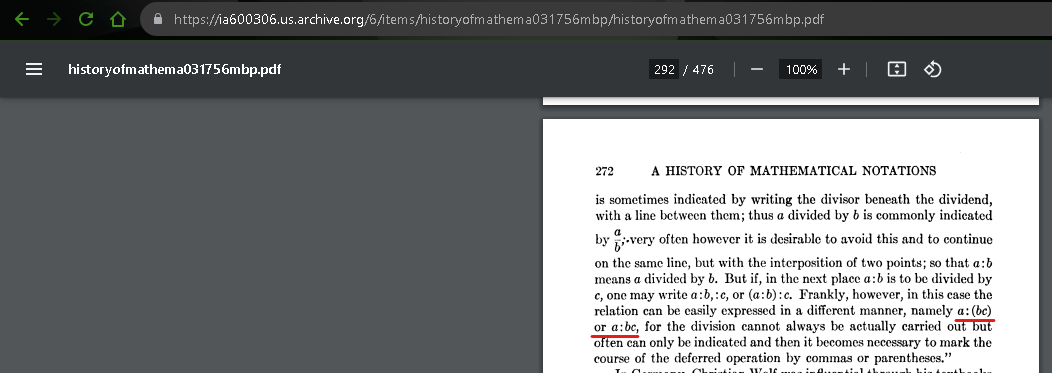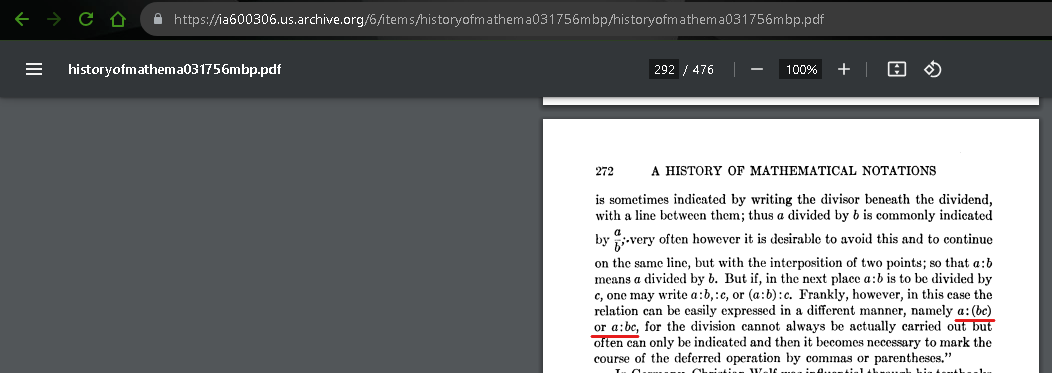watches the people with basic math skills fight to the death over the answer
If you really wanna see a bloodbath, watch this:
You flip two coins. At least one of them is heads. What is the probability that the other one is heads?
50%, since the coins are independent, right?
Oops, I changed it to a more unintuitive one right after you replied! In my original comment, I said “you flip two coins, and you only know that at least one of them landed on heads. What is the probability that both landed on heads?”
And… No! Conditional probability strikes again! When you flipped those coins, the four possible outcomes were TT, TH, HT, HH
When you found out that at least one coin landed on heads, all you did was rule out TT. Now the possibilities are HT, TH, and HH. There’s actually only a 1/3 chance that both are heads! If I had specified that one particular coin landed on heads, then it would be 50%
No. It’s still 50-50. Observing doesn’t change probabilities (except maybe in quantum lol). This isn’t like the Monty Hall where you make a choice.
The problem is that you stopped your probably tree too early. There is the chance that the first kid is a boy, the chance the second kid is a boy, AND the chance that the first kid answered the door. Here is the full tree, the gender of the first kid, the gender of the second and which child opened the door, last we see if your observation (boy at the door) excludes that scenario.
1 2 D E
B B 1 N
B G 1 N
G B 1 Y
G G 1 Y
B B 2 N
B G 2 Y
G B 2 N
G G 2 Y
You can see that of the scenarios that are not excluded there are two where the other child is a boy and two there the other child is a girl. 50-50. Observing doesn’t affect probabilities of events because your have to include the odds that you observe what you observed.
deleted by creator
I was about to reply to you with a comment that started with “oh shit you’re right!” But as I wrote it I started rethinking and I’m not sure now.
Because I actually don’t think it matters whether we’re BB1 or BB2. They’re both only one generation of the four possible initial states. Which child opens the door is determined after the determination of which child is which gender. Basically, given that they have two boys, we’re guaranteed to see a boy, so you shouldn’t count it twice.
Still, I’m now no where near as confident in my answer as I was a moment ago. I might actually go and write the code to perform the experiment as I outlined in an earlier comment (let me know if you think that methodology is flawed/biased, and how you think it should be changed) to see what happens.
That’s a great idea let me know how it turns out. If you randomly pick the genders and randomly pick who opens the door, I think it will be 50-50. With these kinds of things they can get pretty tricky. Just because an explanation seems to make sense doesn’t mean it’s right so I’m curious!
I put it together. Here’s the code I wrote in Python.
import random genders = ['boy', 'girl'] def run(): other_child_girls = 0 for i in range(10000): other_child = get_other_child() if other_child == 'girl': other_child_girls += 1 print(other_child_girls) def get_other_child(): children = random.choices(genders, k=2) first_child_index = random.randint(0, 1) first_child = children[first_child_index] if first_child == 'boy': other_child_index = (first_child_index + 1) % 2 return children[other_child_index] # Recursively repeat this call until the child at the door is a boy # (i.e., discard any cases where the child at the door is a girl) return get_other_child() if __name__ == '__main__': run()And it turns out you were right. I ran it a few times and got answers ranging from 4942 to 5087, i.e., clustered around 50%.
And this interaction is why lemmy (and others) is superior. No “fuck you, you’re wrong” just “well I think it’s this” followed by “okay, let me try that” 10/10
Yes! They responded to my comment before the edit, where I gave the coin example: “I flipped two coins, at least one of them was heads. What is the probability that both of them are heads?”
Before I read their reply, I edited it to the more confusing and infuriating two kids example. It’s annoying because it seems like it should be the same as saying “I have two children, and at least one is a boy. What is the probability that I have two boys?” In both the coin case and this one, the answer is 1/3, but when one child answers the door, it’s like sliding one quarter out from behind my hand. Now you know a particular (child, coin)'s (sex, face), and the answer is 50% again.
This is a ridiculous argument when taken to the extreme. Say you have three bags. Bag A contains 100 blue marbles. Bag B contains 99 blue marbles and 1 red marble. Bag C contains 100 red marbles. You reach into a random bag and draw a red marble. You’ve only eliminated bag A. Would you say it is a 50-50 whether you are left with a bag now containing 99 blue marbles or 99 red marbles? No, the fact that you drew a red marble tells you something about the composition of the bag you drew from. The odds that you drew out of bag B is 1/101, the total number of red marbles in bag B divided by the total number of red marbles across all bags. The odds that you are dealing with bag C is 100x that.
Now let’s say you have 4 bags. BB, BR, BR, and RR. You draw an R. There is a 50% chance you are dealing with bag 2 or 3 because together they contain 2 out of 4 R. There is also a 50% chance you are dealing with bag 4. So it is equally likely that you draw either color of marble if you take the remaining marble out of the bag you randomly selected despite there being twice as many BR bags as RR bags.
You assume that the probability of TH = HT = HH
When In fact, the probabilities are as follows:
P(HT)+P(TH) = 50% P(HH) = 50%
For all the probabilities being equal, you’d have to consider 4 cases:
HT, TH, HH (1) and HH (2).
The difference between HH (1) and HH (2) is which one you were told that was heads.
Then P(HH) = P(HH (1)) + P(HH (2)) = 2/4 = 50%
The issue is that you weren’t told a particular one was heads, only that at least one was heads. If I flipped a nickel and a dime, then the four possibilities are NtDt, NtDh, NhDt, and NhDh. If I say that at least one of them is heads but don’t tell you which one, then there are three possibilities: I flipped NhDt, NtDh, or NhDh. It’s only when I tell you that the nickel landed on heads that it collapses to NhDt and NhDh.
Sorry if the acronyms are hard to read, they’re much faster than typing something like “Heads (nickel) tails (dime)”
Again, you are assuming that every occurrence has the same chance. When in fact, they have not. There are 3 random events happening here:
- Flip of one coin (50% chance each)
- Flip of the other coin (50% chance each)
- The coin that you told me (let’s say it’s 50% nickel 50% dime for simplicity’s sake)
Also, I am assuming that these 3 events are completely unrelated. That is, the result of a coin flip won’t determine whether you tell me the nickel or dime. A complete list of events is as follows:
T T N
T T D
H T N
H T D
T H N
T H D
H H N
H H D
After telling me that one of them is heads, the list is as follows:
H T D
T H N
H H D
H H N
H H is 50% chance, and the sum of HT + TH is the other 50%
This is very easily simulated. I use Tasker, you can use Python or something. Assume 1 is heads and 2 is tails
-
Randomize variable %dime to 1 or 2
-
Randomize variable %nickel to 1 or 2
This flips two coins. At this point there’s a 25% chance of each TT, TH, HT, and HH occurring.
- Goto 1 IF %dime != 1 AND %nickel != 1
This is the point where I tell you that at least one of them is heads, but not which. It flips the coins again only if they landed TT, which means there are three possible sets of coins now: TH, HT, or HH.
-
Add 1 to variable %HeadsTails IF %dime = 2 OR %nickel = 2
-
Add 1 to variable %HeadsHeads IF %dime = 1 AND %nickel = 1
This keeps track of what sets made it past line 3. If either is tails, it adds one to %HeadsTails. If neither is tails, then it adds one to %HeadsHeads
-
Add 1 to variable %Counter
-
Goto 1 IF %Counter <1000
You can set your counter as high as you like. Python would probably handle 10,000 flips faster than Tasker can handle 1,000, but I’m on my phone and also python illiterate.
Press play, and I get 357 sets with two heads, and 643 sets that have a tails. The longer it runs, the closer to a ratio of 1:2 it’ll get.
-
i hate it when ppl do nb erasure for their stupid math text problems. use anything else pls
What’s the probability of the other kid being non-binary?
This is basically Monty Hall right? The other child is a girl with 2/3 probability, because the first one being a boy eliminates the case where both children are girls, leaving three total cases, in two of which the other child is a girl (BG, GB, BB).
Actually, it’s a Monty Hall problem because a door is opened.
Unironically, yes. A door is opened, and the opening of that door reveals information about the problem and eliminates some possible world-states.
It doesn’t, thougb. The Monty Hall problem utilizes the fact that there were more possibilities before one was eliminated AND that it cannot eliminate the “best” outcome. No such qualities are at play here.
The question being asked here is “what is the gender of the second child?” The gender of the first child is completely irrelevent. Observed or unobserved, door open or closed, it doesn’t impact the outcome of the second child.
I suspect it’s not the question OP intended to ask, but it’s the question they asked nonetheless.
The Monty Hall problem utilizes the fact that there were more possibilities before one was eliminated
So does this problem. There was the GG possibility.
AND that it cannot eliminate the “best” outcome.
True, this problem doesn’t have that element.
The question being asked here is “what is the gender of the second child?” The gender of the first child is completely irrelevent. Observed or unobserved, door open or closed, it doesn’t impact the outcome of the second child.
I don’t agree. First, I’d say your use of the term “second child” is ambiguous, because normally that would mean “the younger of two children”, which obviously isn’t what’s meant here. What you mean to say here is “the child that we have not already seen”. It’s in that rephrasing that it becomes obvious that having observed the first child matters, because there cannot be a second until there has been a first. And it’s in that observation that the outcome is altered.
If we haven’t seen the first child and are asked “what will be the gender of the second child to walk through the door?” we would have to answer 50/50. But having seen one child, we eliminate one of four possibilities of gender pairs (BB, BG, GB, GG). This we are left with 3 equally possible cases, 2 of which will be the opposite of the gender of the child we saw first.
Of course, we could easily simulate this experiment to arrive at an empirical answer. Randomly generate 2 genders, randomly select one of those. If they’re a girl, end the experiment and move to another iteration (because they didn’t fit the parameters). If a boy, record the gender of the other child. Repeat a few dozen times and see how many times the second child was a girl.
You can’t just end the experiment if the randomly chosen child doesn’t “fit the parameters”, by doing that you aren’t accounting for half the girls in the whole event pool. Half of the girls have siblings that are girls.
Being 2 girls was a possible event at the start, you can’t just remove it. This time it happened to be a boy who opened the door, but it could’ve been as likely for a girl to open it.
If it was phrased like “there are 2 siblings, only boys can open doors. Of all the houses that opened their doors, how many have a girl in them?”, then it will be 2/3. In this example, there is an initial pool of events, then I narrowed down to a smaller one (with less probability). If you “just” eliminate the GG scenario, then the set of events got smaller without reducing the set’s probability.
Well, I guess OPs point is demonstrated. People will in fact argue about it.
What you’re trying to present has multiple holes, but only one matters: you’re not paying attention to the question that’s being asked. You can say first, second, alpha, beta, Leslie, whatever you want to assign the child in question as, but the question only asks you the gender of a singular child. The door opening child doesn’t matter, because it isn’t part of the question. No one asked what gender that child is. No one asked what the odds they have a female child is. It just isn’t a part of the question.
Yes, I referred to it as the second child because the question that was asked happens to have a child in it and ask you about another. Because we’re communicating in a hilariously precise language, we have to say “the other child”. But that doesn’t make the door opening child a part of the equation. The question could be “there is a child in a box. What are the odds the child is female? Oh, it has a brother by the way.” Cool, who cares, the sibling wasn’t a part of the question.
The Monty Hall problem spreads multiple outcomes across multiple choices and then eliminates one. The outcomes and options have a relation. This question just asks you about a singular variable with two possible outcomes and throws around an unrelated red herring.
It’s somewhat ambiguous!
On the one hand, you might be right. This could be akin to flipping two coins and saying that at least one is heads. You’ve only eliminated GG, so BG, GB, and BB are all possible, so there’s only a 1/3 chance that both children are boys.
On the other hand, you could say this is akin to flipping two coins and saying that the one on the left (or the one who opened the door) is heads. In that case, you haven’t just ruled out GG, you’ve ruled out GB. Conditional probability is witchcraft
I don’t think the problem is conditional probability, it’s translating word problems to maths problems.
If you make the assumptions I made, the maths is unambiguous. Namely, I assumed that a child has a 50/50 probability of being born a boy or a girl. I assumed the child who opens the door is random. I don’t think I made any other assumptions that could have been made any other way. With those assumptions, I’m pretty confident my answer is the only correct one, though I’d love to see an argument otherwise.
If the probability of a child being a girl is different, say, 52%, that will affect the result.
More interestingly, if the probability of which child opens the door is different, that will affect the result. If there’s a 100% chance the elder child opens the door, it goes to 50/50 of the gender of the second child. This makes it like the “coin on the left” example you gave.
If we said the elder child is going to open the door 75% of the time…well, the maths becomes more complicated than I can be bothered with right now. But it’s an interesting scenario!
Assuming the chance of either sex is equal, this problem can be broken down into multiple cases. The first is that there are two unseen kids in the house. What’s the probability they are both boys? 1/4. Now the door opens and you see two boys. The probability both are boys is 1/1. But if you only see one boy, the problem simplifies into the probability of a child being a boy. One of the probabilistic events postulated in the original problem is fixed at 1. So the answer is 1/2.
Think of it as the two coin flip, except one coin has two heads. That simplifies to a one coin flip.
No, because knowing the first child is a boy doesn’t tell you any information about the second child.
Three doors, Girl Girl Boy
You select a door and Monty opens a door to show a Girl. You had higher odds of picking a girl door to start (2/3). So switching gives you better odds at changing to the door with the Boy because you probably picked a Girl door.
Here the child being a boy doesn’t matter and the other child can be either.
It’s 50/50 assuming genders are 50/50.
Well not really, right? BG and GB are the same scenario here, so it’s a 50/50 chance.
Even if, say, the eldest child always opened the door, it’d still be a 50/50 chance, as the eldest child being a boy eliminates the possibility of GB, leaving either BG or BB.
Ironically you’ve got the right answer, but (as you can see in some of the other conversation here) not necessarily for the right reason. It’s not necessarily that BG and GB are the same, but that BB and BB are two different scenarios worthy of being counted separately.
Why is it that BB and BB are being counted separately? I thought that order didn’t matter: you could have two girls, a boy and a girl (or vice versa, same thing), or a two boys. (And then by eliminating two girls you’d have a 50/50 chance).
Because describing it as I did in that comment is a (very) shorthand way of getting at how it was explained in full by @[email protected] in this comment.
Just read it: makes sense now. Thanks!
Two more for funsies! I flipped two coins. At least one of them landed on heads. What is the probability that both landed on heads? (Note: this is what my comment originally said before I edited it)
I have two children. At least one of them is a boy born on a Tuesday. What is the probability that I have two boys?
Cheeky bastard.
It is 50-50, though. The remaining possible states are BG and BB. Both are equally likely. Any further inference is narrative… not statistics.
The classic example of this is flipping 100 coins. If you get heads 99 times in a row… the last coin is still 50-50. Yes, it is obscenely unlikely to get heads 100 times in a row. But it’s already obscenely unlikely to get heads 99 times in a row. And it is obscenely unlikely to alternate perfectly between heads and tails. And it is obscenely unlikely to get a binary pattern spelling out the alphabet. And it is obscenely unlikely to get… literally any pattern.
Every pattern is equally unlikely, with a fair coin. We see 99 heads in a row versus 1 tails at the end, and think it narrowly averted the least-probable outcome. But only because we lump together all sequences with exactly one tails. That’s one hundred different patterns. 1-99 is not the same as 99-1. We just treat them the same because we fixate on uniformity.
Compare a non-binary choice: a ten-sided die. Thirty 1s in a row is about as unlikely as 100 heads in a row. But 1 1 1… 2 is the same as 1 1 1… 3. Getting the first 29 is pretty damn unlikely. One chance in a hundred million trillion. But the final die can land on any number 1-10. Nine of them upset the pattern our ape brains want. Wanting it doesn’t make it any more likely. Or any less likely.
It would be identically unlikely for a 10-sided die to count from 1 to 10, three times in a row. All the faces appear equally. But swap any two events and suddenly it doesn’t count. No pun intended.
If this couple had eight children, for some god-forsaken reason, and you saw seven boys, the eighth kid being another boy is not less likely for it. The possibility space has already been reduced to two possibilities out of… well nine, I suppose, if order doesn’t matter. They could have 0-8 boys. They have at least 7. The only field that says the last kid’s not a coin toss is genetics, and they say this guy’s chromosome game is strong.
You’re right, but it’s not a subversion of the Gambler’s Fallacy, it’s a subversion of conditional probability. A classic example is that I have two kids, and at least one of them is a boy. What is the probability that I have two boys?
The intuitive answer is 50%, because one kid’s sex doesn’t affect the other. But when I told you that I have two kids, there were four possibilities: GG, GB, BG, or BB. When I told you that at least one of them is a boy, all I did was take away the GG option. That means there’s only a 1 in 3 chance that I have two boys.
But by having one child answer the door, I change it yet again–now we know the sex of a particular child. We know that the child who opened the door is a boy. This is now akin to saying “I have two children, and the eldest is a boy. What is the possibility that I have two boys?” It’s a sneaky nerd snipe, because it targets specifically people who know enough about statistics to know what conditional probability is. It’s also a dangerous nerd snipe, because it’s entirely possible that my reasoning is wrong!
Different compilers have robbed me of all trust in order-of-operations. If there’s any possibility of ambiguity - it’s going in parentheses. If something’s fucky and I can’t tell where, well, better parenthesize my equations, just in case.
There’s quite a few calculators that get this wrong. In college, I found out that Casio calculators do things the right way, are affordable, and readily available. I stuck with it through the rest of my classes.
Casio does a wonderful job, and it’s a shame they aren’t more standard in American schooling. Texas Instruments costs more of the same jobs, and is mandatory for certain systems or tests. You need to pay like $40 for a calculator that hasn’t changed much if at all from the 1990’s.
Meanwhile I have a Casio fx-115ES Plus and it does everything that one did, plus some nice quality of life features, for less money.
If you’re lucky, you can find these TI calculators in thrift shops or other similar places. I’ve been lucky since I got both of my last 2 graphing calculators at a yard sale and thrift shop respectively, for maybe around $40-$50 for both.
$40??!! My ti that was required was like over $200!!
TI did the same thing Quark and Adobe did later on – got dominance in their markets, killed off their competition, and then sat back and rested on their laurels thinking they were untouchable
EDIT: although in part, we should thank TI for one thing – if they hadn’t monopolized the calculator market, Commodore would’ve gone into calculators instead of computers
https://en.wikipedia.org/wiki/TI-99/4A
It was a huge failure, but they tried.
The TI equivalent to the Casio fx-115ES Plus is the TI-36X Pro, and they both cost $20 at Walmart.
Sharp as well.
My Casio calculators get this wrong, even the newer ones. BTW the correct answer is 16, right?
the correct answer is 16, right?
Depends on the system you use. Most common system worldwide and in the academic circles (the oldest of the two) has 1 as the answer.
Depends on the system you use
There are no other systems - only people who are following the actual rules of Maths and those who aren’t. And yes, 1 is the correct answer
- 16 is the right answer if you use PEMDAS only:
(8 ÷ 2) × (2 + 2) - 1 is the right answer if you use implicit/explicit with PEMDAS:
8 ÷ (2 × (2 + 2)) - both are correct answers (as in if you don’t put in extra parentheses to reduce ambiguity, you should expect expect either answer)
- this is also one of the reasons why postfix and prefix notations have an advantage over infix notation
- postfix (HP, RPN, Forth):
2 2 + 8 2 ÷ × . - prefix (Lisp):
(× (÷ 8 2) (+ 2 2))
- postfix (HP, RPN, Forth):
16 is the right answer if you use PEMDAS only: (8 ÷ 2) × (2 + 2)
You added brackets and changed the answer. 2(2+2) is a single term, and if you break it up then you change the answer (because now the (2+2) is in the numerator instead of in the denominator).
1 is the right answer
The only right answer
both are correct answers
Nope, 1 is the only correct answer.
this is also one of the reasons why postfix and prefix notations have an advantage over infix notation
Except they don’t. This isn’t a notation problem, it’s a people don’t remember the rules of Maths problem.
prefix notation doesn’t need parentheses either though, at least in this case. lisp uses them for readability and to get multiple arity operators. infix doesn’t have any ambiguity either if you parenthesize all operations like that.
infix doesn’t have any ambiguity either if you parenthesize all operations like that
There isn’t any ambiguity even if you don’t.
- 16 is the right answer if you use PEMDAS only:
Yes
8 / 2 (2+2) 8 / 2 (4) 4 (4) 16
No
8 / 2 (2+2)
8 / 2 (4)
8 / 8
1
a(b) is a×b. Step 2 could be rewritten as 8 / 2 × 4. Working left to right, step 3 becomes 4 × 4.
No, because implicit multiplication binds more tightly than explicit. a/b© becomes a/(bש)
Says who?
Says who?
Everyone with a degree in mathematics, science or engineering.
Most maths textbooks written by mathematicians.
I don’t mean when they’re explaining “here’s how the order of operations works”. I mean in the basic way that they write more advanced problems and the answers they give for them.
This video, and the prequel to it linked in the description, go into some detail showing who uses what convention and why.
Right answer, wrong words. The actual rules are Terms and The Distributive Law.
That’s exactly where the calculators in the op differ. For more examples, Casio calculators do implicit multiplication first, while ti’s treat it the same as explicit multiplication and division. I think that the latter is more predictable personally, but really you just need to know your calculator.
Casio calculators do implicit multiplication first
Actually they follow the actual rules of Maths - Terms and The Distributive Law.
a(b) is a×b
a(b) is (a×b) - you can’t remove brackets unless there is only 1 term left inside.
8/(2x4)=8/8=1
No. Order of operations is left to right, not right to left. 1 is wrong.
Pemdas.
Multiplication comes before division.
1 is the correct answer.
deleted by creator
There’s an argument to be made that implicit multiplication comes before division, resulting in the answer 1, but all multiplication? That’s wrong, full-stop. You calculate (explicit) multiplication and division in one step, left to right. Reason being that division is technically just multiplying by the reciprocal.
1 is the correct answer, but it’s because Brackets comes before Division - there is no Multiplication in this problem.
That’s wrong. Multiplication and division have equal precedence, same as addition and subtraction. You do them left to right. PEMDAS could be rewritten like PE(MD)(AS). After parentheses and exponents, it"s Multiplication and division together, then addition and subtraction together. They also teach BODMAS some places, which is “brackets, order, division and multiplication, addition and subtraction” Despite reversing the division and multiplication, it doesn’t change the order of operations. They have the same priority, so they are just done left to right. PEMDAS and BODMAS are the different shorthand for the same order of operations.
They were right but for the wrong reason. Implied multiplication–that is, a(b) or ab–often comes before explicit multiplication and division. Apparently it’s up to the person writing the equation, so the meme is intentionally and explicitly ambiguous
Order of operations is left to right
Order of operations is BEDMAS, THEN left to right within each operator.
1 is wrong
1 is the only correct answer.
Yes
No.
8 / 2 (4) 8/(2x4) 8/8 1
deleted by creator
No, 8 / 2 happens before 2 * 4
That’s (2x4). Doing division before brackets goes against the order of operations rules.
deleted by creator
Division and multiplication are equal in the order of operations
I didn’t say they weren’t. I said…
Doing division before brackets goes against the order of operations rules
You did 8/2x4, which is the same as (8/2)(2+2), which isn’t the same as 8/2(2+2)=8/2(4)=8/(2x4).
Ditto for Sharp. It’s really only Texas Instruments that is the ongoing exception to the rule.
there’s a setting in Qalculate! that asks if you want implicit multiplication to apply to the denominator or the numerator
This is why I loved my Casio 2D. It could use actual fractions to avoid these kind of issues
I don’t understand why people say Maths. Math encompasses every single type of Math. Maths is just wrong.
This is exactly why we have Reversed Polish Notation. When will people learn?
Is this HiPER Calc with ads? Did the free version have those?
People keep debating over this stuff. I have a simpler solution. Math is not real.
The correct answer is 16. Multiplication and Division happen at the same level of priority, and are evaluated left-to-right.
No it’s ambiguous, you claiming there is one right answer is actually wrong.
But there actually is only 1 right answer, and unfortunately for the person you’re replying to it’s 1.
It is not ambiguous at all, there absolutely is one right answer, and it is 16.
You’re taking something you learned when you were like 9 years old and assuming it’s correct in every situation forever.
Unfortunately this isn’t the case and you’re incorrect.
Inaccurate, this has nothing to do with the mnemonic PEMDAS, this has to do with the actual order of operations it tries to instill. That order of operations is not ambiguous, there is a correct way to solve simple equations like the one above, and there is one and only one correct answer to it. That answer is 16.
And in the “actual” order of operations, if we want to pretend one exists,
2(binds more tightly than÷if you’re going via prescriptivism, then you’re wrong, because there are plenty of authoritative sources following the left hand model
if you’re going via descriptivism, then you’re wrong, because this thread exists
No, 2( does not bind more tightly than ÷. 2( is simply 2×(…, and ÷ and × occur at the same level of priority. After resolving the addition in the parentheses, the remaining operations are resolved left to right.
if you’re going via prescriptivism, then you’re wrong, because there are plenty of authoritative sources following the left hand model
if you’re going via descriptivism, then you’re wrong, because this thread exists
2( is simply 2×(
No it isn’t. 2(a+b)=(2a+2b) The Distributive Law
PEMDAS be damned?
PEMDAS should be read as Parentheses, Exponents, Multiplication and Division, Addition and Subtraction. There are four levels of priority, not six.
[…] the question is ambiguous. There is no right or wrong if there are different conflicting rules. The only ones who claim that there is one rule are the ones which are wrong!
https://people.math.harvard.edu/~knill/pedagogy/ambiguity/index.html
As youngsters, math students are drilled in a particular
convention for the “order of operations,” which dictates the order thus:
parentheses, exponents, multiplication and division (to be treated
on equal footing, with ties broken by working from left to right), and
addition and subtraction (likewise of equal priority, with ties similarly
broken). Strict adherence to this elementary PEMDAS convention, I argued,
leads to only one answer: 16.Nonetheless, many readers (including my editor), equally adherent to what
they regarded as the standard order of operations, strenuously insisted
the right answer was 1. What was going on? After reading through the
many comments on the article, I realized most of these respondents were
using a different (and more sophisticated) convention than the elementary
PEMDAS convention I had described in the article.In this more sophisticated convention, which is often used in
algebra, implicit multiplication is given higher priority than explicit
multiplication or explicit division, in which those operations are written
explicitly with symbols like x * / or ÷. Under this more sophisticated
convention, the implicit multiplication in 2(2 + 2) is given higher
priority than the explicit division in 8÷2(2 + 2). In other words,
2(2+2) should be evaluated first. Doing so yields 8÷2(2 + 2) = 8÷8 = 1.
By the same rule, many commenters argued that the expression 8 ÷ 2(4)
was not synonymous with 8÷2x4, because the parentheses demanded immediate
resolution, thus giving 8÷8 = 1 again.This convention is very reasonable, and I agree that the answer is 1
if we adhere to it. But it is not universally adopted.Exactly, explicit multiplication is part of the parenthesis so it comes first in order of operations
[…] the question is ambiguous. There is no right or wrong if there are different conflicting rules. The only ones who claim that there is one rule are the ones which are wrong!
https://people.math.harvard.edu/~knill/pedagogy/ambiguity/index.html
Yeah nah. Actual Maths textbooks and proofs - did you not notice the complete lack of references to textbooks in the blog? It’s funny that he mentions Cajori though, given Cajori has a direct reference to Terms #MathsIsNeverAmbiguous

I think I’m gonna trust someone from Harvard over your as-seen-on-TV looking ass account, but thanks for the entertainment you’ve provided by trying to argue with some of the actual mathematicians in here
I think I’m gonna trust someone from Harvard
So you’re going with the appeal to authority argument - ok, got it.
But if you’re gonna do that then make sure you check out Cajori’s credentials, since that’s, you know, who we both quoted.
argue with some of the actual mathematicians in here
You mean the dude who claimed to be, and was quoting wikipedia? BWAHAHAHAHA
That’s cool, but still wrong :3
Everyone in this threading referencing PEMDAS and still thinking the answer is 1 are completely ignoring the part of the convention is left to right. Only way to get 1 is to violate left to right on multiplication and division.
Only way to get 1 is to violate left to right on multiplication and division
Actually the only way to get 16 is to ignore one of more rules of Maths - sometimes it’s Terms, sometimes it’s The Distributive Law, but always something. If you follow all the rules of Maths you get 1.
The problem is that BIDMAS and its variants are lies-to-children. Real mathematicians don’t use BIDMAS. Multiplication by juxtaposition is extremely common, and always takes priority over division.
Nobody in their right minds would saw 1/2x is the same as (1/2)x. It’s 1/(2x).
That’s how you get 1. By following conventions used by mathematicians at any level higher than primary school education.
The problem is the /. Usually you’d use a fraction bar, which groups it and makes it unambiguous
Usually you’d use a fraction bar, which groups it and makes it unambiguous
Division (operator) and fraction bar (grouping symbol) aren’t the same. It already is unambiguous.
There are plenty of contexts where writing in a single flat line is necessary, so it’s still useful to address the issue.
Just using more brackets is always a solution, but it can become messy and hard to read if you take it to the extreme (there’s a Minute Physics video where he does this and it unintentionally shows you just how bad it is), so it eventually becomes a matter of agreeing on convention and using brackets judicially where there’s actual ambiguity.
I only minored in math but I definitely see (1/2)x. That’s how I always entered polynomials into my ti-83 plus
Edit for clarity: I’d enter “1/2x”, as in 0.5x. Casio people have to use parenthesis or explicit multiplication though
Source? I have a hard ass time believing that nobody in their right mind would do pemdas the way you’re supposed to do it xD
The problem is that you’re thinking of BIDMAS as a set of hard rules, rather than the set of rough guidelines created in the early 20th century by one random teacher for the purposes of teaching 10-year-olds how to do the level of maths that 10-year-olds do.
This video and this one point to some examples of style guides in academia as well as practical examples in the published works of mathematicians and physicists, which are pretty consistent.
If you want to come up with a hard rule, doing BIJMDAS, adding in “multiplication indicated by juxtaposition” with the J, is a much better way to do it than what you learnt when you were 10. But even that’s still best to think of as a handy guideline rather than a hard and fast rule.
That’s cool, but still wrong :3
No fr I had no idea that those acronyms weren’t the whole picture, I just assumed some mathematicians a long time ago decided how that stuff should be written out and that BEDMAS/PEMDAS/whatever contained all the rules in it. Thank you for the info, Idk why this isn’t more widely taught, ig because those acronyms are what all the questions are already written for? It doesn’t seem that hard to just teach it as BEADMAS, where the A refers to numbers adjacent to variables
It doesn’t seem that hard to just teach it as BEADMAS, where the A refers to numbers adjacent to variables
Terms already are taught!
Source?
Cajori (1928) for starters, plus any old Year 7 Maths textbook, any era (we know from Lennes letter that textbooks were already doing this in 1917).

pink tax strikes again
I don’t think you encounter this one very often, but the technically correct “-2^2 = -8” has a higher chance of ruining your day.





















